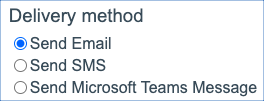Notification actions, formerly Email/SMS actions, are used to send notifications, such as emails or messages, to a user, email address, or team of users based on a template. Notifications are typically sent automatically using rules, action buttons, or workflows, rather than triggered manually. When a Notification action is run on several records, the results can be sent individually or collated into a single notification containing all of the relevant records.
To send notifications by email, you must have email set up to send from records for that table. For more information, see Implementing Outbound Email. To send notifications in Microsoft Teams, you must set up the Agiloft app in at least one Teams channel. For more information, see Setting Up Agiloft for Microsoft Teams. To send notifications by SMS, you must have SMS messaging set up. For more information, see SMS. |
Create a Notification Action
You can access the Actions wizard in several ways, but the easiest way is to select Setup [Table] from the table where you want to create the action.
- From the top nav bar, expand the table's drop-down and select Setup [Table].
- Select the Actions tab in the Table wizard.
- Click Create Notification Action.
On the General tab, name your action and give it a description.
Once your action is saved, the system automatically adds an E: before your given title. This is because Notification actions were previously called Email/SMS actions. |
- Choose whether you want to send the message through email, SMS, or Microsoft Teams.

- Navigate to the Message tab and either select an existing template or click New to create a new template.
In the template, select the message recipients. Notifications can be addressed to multiple recipients who are selected based on the User, Team, Email, or fields in the record. Teams messages can be sent to a channel where the Agiloft app has been configured. Messages can also be addressed to specific, hard-coded email addresses, but this method is not recommended.
Notifications sent to a team are sent to the individual members of that team, using the permissions of each individual. However, if the "Allow emails to be sent to this team" field in the team's record is set to No, the notification is not sent at all. |
- Compose the subject and body of the notification. Notifications can contain specified fields from the record, attachments, and multiple hyperlinks, which allow the recipient to log in and either edit or view the record. They can be sent in either HTML or plain text format.
- Click Finish.
When creating an Email action, you can create a message using an existing template by going to Insert > Populate from template and choosing the template. For example, choosing the "Email Contract Owner about renewal date" action results in a message that already contains predefined text and variables, as well as a link to update the contract record. When the action runs, the variables are populated with their appropriate values. 
|
Related articlesRelated articles appear here based on the labels you select. Click to edit the macro and add or change labels. 
|

